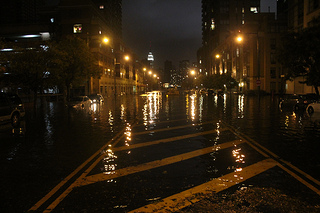After the Storm: FAQs from The Genealogy Event
Biff Barnes
We’ve been offline for a bit. We really enjoyed attending the Genealogy Event in New York City last weekend, but it put us in town for the arrival of Hurricane Sandy. Squarespace, which hosts our website, is in Lower Manhattan. They have backup generators, but they are located in the basement which flooded during the storm. We got a message that everything would be down for a while. Obviously a small inconvenience in light of the magnitude of the damage the East Coast has suffered. We’re glad to be back online. So back to our blog.
 Courtesy of metamatic under Creative Commons
Courtesy of metamatic under Creative Commons
The Genealogy Event was an excellent conference. We met a lot of enthusiastic people who want to create family histories. Today’s post will highlight some of the frequently asked questions from the event.
- I’m not ready yet. This was probably the most frequent comment of people who stopped at our booth. In talking to these people it became clear that their real question was: How will I know when I am ready to write my family history? We discussed the fact that genealogical research is a pursuit that is infinite. No one is ever done. But books are finite. They include only a limited segment of that infinite research. The first step in writing a book is setting a goal. Begin with a statement like I will be ready to publish my family history by (fill in a date).Often people like to tie the completion of a book to an important holiday or family event. It will be completed for next Christmas. Or, I want to have it done for grandma’s 90th birthday? Or, I’ll need it for the family reunion in 2014. Once you have a date in mind, you can plan backward to schedule what you will need to do to meet that deadline.
- How do I decide what goes into the book? Setting the goal usually helps people to recognize that they can’t include everything in a single volume. The easiest way to manage the information you have accumulated through your research is to set limits for the scope of your book. Decide upon one line of the family and focus on that line. If you want to write about other lines that’s for other books. Or, set a chronological limit. Go back three or four generations. Setting limits will make information manageable.
- Is it okay to…? Our answer is generally: There are no rules. Every family is unique and the book that tell its story is unique too. As the author of a family history, you need to consider the audience for which you are writing. If you want to produce a book that future genealogists will use as a reference, you will want to create a factual record with full documentation, footnotes and endnotes. But if your primary goal is to provide a family history that will engage the grandchildren you’ll you want to focus on family stories and a more narrative approach to the family history. Which is best? That’s up to you.
- Take inventory. When you set a goal, decided upon the scope of your book, and considered your audience you can begin to plan your book. You can develop a tentative outline that will eventually become your book’s table of contents. As you do you can take inventory of the research you have done and the images you have to accompany it. If you don’t have all the information you need you can do targeted research to get it. Maybe you want to know where great-grandfather first live when he arrived from the old country. You can use census records to find out. Then you can look for a photo of the building or neighborhood. This focused research feels a lot more manageable than simply continuing to work on the family genealogy. It also moves you toward your goal of completing your book.
The most important thing we wanted to communicate to people was that they can create a family history book for their family. Genealogists are great a doing things systematically. Taking the time to develop a plan for a family history book will allow you to apply that same systematic approach to your book.